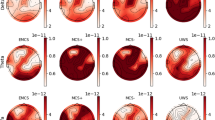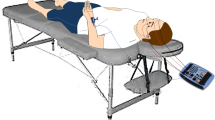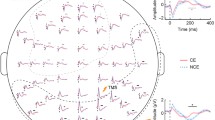Abstract
Although patients with chronic disorders of consciousness (DOC), including unresponsive wakefulness syndrome (UWS) and minimally conscious state (MCS), show a limited repertoire of awareness signs, owing to a large-scale cortico–thalamo–cortical functional disconnectivity, an activation of some cortical areas in response to relevant stimuli has been described by means of electrophysiological and functional neuroimaging approaches. In addition, cognitive processes associated with autonomic nervous system (ANS) responses elicited by nociceptive stimuli have been identified in some DOC patients. In an attempt to identify ANS functionality markers that could be useful in differentiating UWS and MCS individuals, we measured the amplitude, latency and γ-band power (γPOW) of ultra-late laser-evoked potentials (CLEPs) and skin reflex (SR), which both express some aspects of cognitive processes related to ANS functionality, besides other ANS parameters either during a 24hh-polygraphy or following a solid-state laser repetitive nociceptive stimulation. MCS showed physiological modification of vital signs (O2 saturation, hearth rate, hearth rate variability) throughout the night and a preservation of SR-γPOW, whereas UWS did not show significant variations. Following repetitive nociceptive stimulation, MCS patients had a significant increase in CLEP-γPOW, O2 saturation, hearth rate, and hearth rate variability, whereas UWS individuals did not show any significant change (but two patients, who reached high Coma Recovery Scale-Revised scores). Hence, our work suggests that a wide-spectrum electrophysiological evaluation of ANS functionality may support DOC differential diagnosis. Interestingly, the two above-mentioned UWS patients showed MCS-like vital sign modifications and electrophysiological pain responsiveness. It is therefore hypothesizable that our approach could be helpful in identifying residual aware autonomic system-related cognitive processes even in some UWS patients. Such issue draws the attention to either DOC clinical diagnosis or adequate pain treatment in DOC patients.




Similar content being viewed by others
References
Appelhans BM, Luecken LJ (2008) Heart rate variability and pain: associations of two interrelated homeostatic processes. Biol Psychol 77:174–182
Appelhans BM, Luecken LJ (2010) Heart rate variability as an index of regulated emotional responding. Rev Gen Psychol 10:229–240
Benarroch EE (1997) Functional anatomy of the central autonomic network. In: Benarroch EE (ed) Central autonomic network: functional organization and clinical correlations. Futura Publishing Co Inc, Armonk, pp 29–59
Berntson GG, Cacioppo JT, Quigley KS (1991) Autonomic determinism: the modes of autonomic control, the doctrine of autonomic space, and the laws of autonomic constraint. Psychol Rev 98:459–487
Berntson GG, Sarter M, Cacioppo JT (2003) Ascending visceral regulation of cortical affective information processing. Eur J Neurosci 18:2103–2109
Bruno MA, Vanhaudenhuyse A, Thibaut A, Moonen G, Laureys S (2011) From unresponsive wakefulness to minimally conscious PLUS and functional locked-in syndromes: recent advances in our understanding of disorders of consciousness. J Neurol 258:1373–1384
Carlson NR (2001) Physiology of behavior. Allyn and Bacon, Boston
Carvalho MJ, van Den Meiracker AH, Boomsma F, Lima M, Freitas J, Veld AJ, Falcao De Freitas A (2005) Diurnal blood pressure variation in progressive autonomic failure. Hypertension 35:892–897
Clausa D, Schondorf R (1999) Sympathetic skin response. In: Deuschl G, Eisen A (eds) Recommendations for the practice of clinical neurophysiology: guidelines of the International Federation of Clinical Physiology. Elsevier, London, pp 277–282
Cologan V, Schabus M, Ledoux D, Moonen G, Maquet P, Laureys S (2010) Sleep in disorders of consciousness. Sleep Med Rev 14:97–105
de Biase S, Gigli GL, Lorenzut S, Bianconi C, Sfreddo P, Rossato G, Basaldella F, Fuccaro M, Corica A, Tonon D, Barbone F, Valente M (2014) The importance of polysomnography in the evaluation of prolonged disorders of consciousness: sleep recordings more adequately correlate than stimulus-related evoked potentials with patients’ clinical status. Sleep Med 15:393–400
De Sousa A (2013) Towards An Integrative Theory Of Consciousness: part 1 (Neurobiological And Cognitive Models). Mens Sana Monogr 11:100–150
Delorme A, Makeig S (2004) EEGLAB: an open source toolbox for analysis of single-trial EEG dynamics including independent component analysis. J Neurosci Methods 134:9–21
Demertzi A, Racine E, Bruno MA, Ledoux D, Gosseries O, Vanhaudenhuyse A, Thonnard M, Soddu M, Moonen G, Laureys S (2013) Pain perception in disorders of consciousness: neuroscience, clinical care, and ethics in dialogue. Neuroethics 6:37–50
Di Perri C, Bastianello S, Bartsch AJ, Pistarini C, Maggioni G, Magrassi L, Imberti R, Pichiecchio A, Vitali P, Laureys S, Di Salle F (2013) Limbic hyperconnectivity in the vegetative state. Neurology 81:1417–1424
Dolce G, Riganello F, Quintieri M, Candelieri A, Conforti D (2008) Personal interaction in vegetative state: a data mining study. J Psychophysiol 22:150–156
Draper K, Ponsford J, Schönberger M (2007) Psychosocial and emotional outcomes 10 years following traumatic brain injury. J Head Trauma Rehabil 22:278–287
Formisano R, D’Ippolito M, Catani S (2013) Functional locked-in syndrome as recovery phase of vegetative state. Brain Inj 27:1332
Giacino JT (2004) The vegetative and minimally conscious states: consensus based criteria for establishing diagnosis and prognosis. NeuroRehabilitation 19:293–298
Giacino JT, Kalmar K, Whyte J (2004) The JFK Coma Recovery Scale-Revised: measurement characteristics and diagnostic utility. Arch Phys Med Rehabil 85:2020–2029
Gross J, Schnitzler A, Timmermann L, Ploner M (2007) Gamma oscillations in human primary somatosensory cortex reflect pain perception. PLoS Biol 5:e133
Huhle R, Burghardt M, Zaunseder S, Wessel N, Koch T, Malberg H, Heller AR (2012) Effects of awareness and nociception on heart rate variability during general anaesthesia. Physiol Meas 33:207–217
Iannetti GD, Hughes NP, Lee MC, Mouraux A (2008) Determinants of laser-evoked EEG responses: pain perception or stimulus saliency? J Neurophysiol 100:815–828
Jacobson NS, Truax P (1991) Clinical significance: a statistical approach to defining meaningful change in psychotherapy research. J Consult Clin Psychol 59:12–19
Kassubek J, Juengling FD, Els T, Spreer J, Herpers M, Krause T, Moser E, Lücking CH (2003) Activation of a residual cortical network during painful stimulation in long-term post-anoxic vegetative state: a 15O–H2O PET study. J Neurol Sci 15:85–91
Lane RD, McRae K, Reiman EM, Chen K, Ahern GL, Thayer JF (2009) Neural correlates of heart rate variability during emotion. Neuroimage 44:213–222
Laureys S, Goldman S, Phillips C, Van Bogaert P, Aerts J, Luxen A, Franck G, Maquet P (1999) Impaired effective cortical connectivity in vegetative state: preliminary investigation using PET. Neuroimage 9:377–382
Laureys S, Faymonville ME, Luxen A, Lamy M, Franck G, Maquet P (2000) Restoration of thalamocortical connectivity after recovery from persistent vegetative state. Lancet 355:1790–1791
Laureys S, Faymonville ME, Peigneux P, Damas P, Lambermont B, Del Fiore G, Degueldre C, Aerts J, Luxen A, Franck G, Lamy M, Moonen G, Maquet P (2002) Cortical processing of noxious somatosensory stimuli in the persistent vegetative state. Neuroimage 17:732–741
Machado C, Korein J, Aubert E, Bosch J, Alvarez MA, Rodriguez R, Valdés P, Portela L, Garcia M, Pérez N, Chinchilla M, Machado Y, Machado Y (2007) Recognizing a mother’s voice in the persistent vegetative state. Clin EEG Neurosci 38:124–126
Multi-Society Task Force on PVS (1994) Medical aspects of the persistent vegetative state. N Engl J Med 330:1499–1508
Napadow V, Dhond R, Conti G, Makris N, Brown EN, Barbieri R (2008) Brain correlates of autonomic modulation: combining heart rate variability with fMRI. Neuroimage 42:169–177
Naro A, Leo A, Bramanti P, Calabrò RS (2015) Moving towards conscious pain processing detection in chronic disorder of consciousness: the Anterior Cingulate Cortex Neuromodulation. J Pain 16:1022–1031
Niskanen JP, Tarvainen MP, Ranta-aho PO, Karjalainen PA (2004) Software for advanced HRV Analysis. Comput Meth Prog Biomed 76:73–81
Öhman A, Hamm A, Hugdahl K (2000) Cognition and the autonomic nervous system: Orienting, anticipation, and conditioning. In: Cacioppo J, Tassinary L, Berntson GG (eds) Handbook of Psychophysiology. Cambridge University Press, New York, pp 533–575
Panza JA, Epstein SE, Quyyumi AA (1991) Circadian variation in vascular tone and its relation to alpha-sympathetic vasoconstrictor activity. New Engl J Med 325:986–990
Peng W, Hu L, Zhang Z, Hu Y (2014) Changes of spontaneous oscillatory activity to tonic heat pain. PLoS One 9:e91052
Pfurtscheller G, Lopes da Silva FH (1999) Event-related EEG/MEG synchronization and desynchronization: basic principles. Clin Neurophysiol 110:1842–1857
Reeves RA, Shapiro AP, Thompson ME, Johnsen AM (1986) Loss of nocturnal decline in blood pressure after cardiac transplantation. Circulation 73:401–408
Richardson DW, Honour AJ, Fenton GW, Stott FH, Pickering GW (1964) Variation in arterial pressure throughout the day and night. Clin Sci 26:445–460
Riganello F, Candelieri A, Quintieri M, Conforti D, Dolce G (2008) Heart rate response to music: an artificial intelligence study on healthy and brain injured subjects. J Psychophysiol 22:166–174
Riganello F, Dolce G, Sannita WG (2012) Heart rate variability and the central autonomic network in the severe disorder of consciousness. J Rehabil Med 44:495–501
Riganello F, Cortese MD, Dolce G, Lucca LF, Sannita WG (2015) The autonomic system functional state predicts responsiveness in DOC. J Neurotrauma 32:1071–1077
Saper CB (2002) The central autonomic nervous system: conscious visceral perception and autonomic pattern generation. Annu Rev Neurosci 25:433–469
Schulz E, May ES, Postorino M, Tiemann L, Nickel MM, Witkovsky V, Schmidt P, Gross J, Ploner M (2015) Prefrontal gamma oscillations encode tonic pain in humans. Cereb Cortex 8:bhv043
Shahani BT, Halperin JJ, Boulu P, Cohen J (1984) Sympathetic skin response–a method of assessing unmyelinated axon dysfunction in peripheral neuropathies. JNNP 47:536–542
Task Force of the European Society of Cardiology and the North American Society of Pacing and electrophysiology of Circulation (1996) Heart rate variability: standard of measurement, physiological interpretation, and clinical use. Circulation 93:1043–1065
Thayer JF (2007) What the heart says to brain (and vice versa) and why we should listen. Psychol Top 16:241–250
Thayer JF, Lane RD (2000) A model of neuro-visceral integration in emotion regulation and deregulation. J Affect Disord 61:201–216
Thayer JF, Lane RD (2007) The role of vagal function in the risk for cardiovascular disease and mortality. Biol Psychol 74:224–242
Tiemann L, May ES, Postorino M, Schulz E, Nickel MM, Bingel U, Ploner M (2015) Differential neurophysiological correlates of bottom-up and top-down modulations of pain. Pain 156:289–296
Tuck ML, Stern N, Sowers JR (1985) Enhanced 24-hour norepinephrine and renin secretion in young patients with essential hypertension: relation with the circadian pattern of arterial blood pressure. Am J Cardiol 55:112–115
Zhang ZG, Hu L, Hung YS, Mouraux A, Iannetti GD (2012) Gamma-band oscillations in the primary somatosensory cortex–a direct and obligatory correlate of subjective pain intensity. J Neurosci 32:7429–7438
Author information
Authors and Affiliations
Corresponding author
Ethics declarations
Conflict of interest
The authors declare that they have no conflict of interest.
Ethical approval
All procedures performed in studies involving human participants were in accordance with the ethical standards of the institutional and/or national research committee and with the 1964 Helsinki declaration and its later amendments or comparable ethical standards.
Informed consent
Informed consent was obtained from all individual participants included in the study.
Additional information
Antonino Leo and Antonino Naro these authors equally contributed to the study.
Rights and permissions
About this article
Cite this article
Leo, A., Naro, A., Cannavò, A. et al. Could autonomic system assessment be helpful in disorders of consciousness diagnosis? A neurophysiological study. Exp Brain Res 234, 2189–2199 (2016). https://doi.org/10.1007/s00221-016-4622-8
Received:
Accepted:
Published:
Issue Date:
DOI: https://doi.org/10.1007/s00221-016-4622-8




